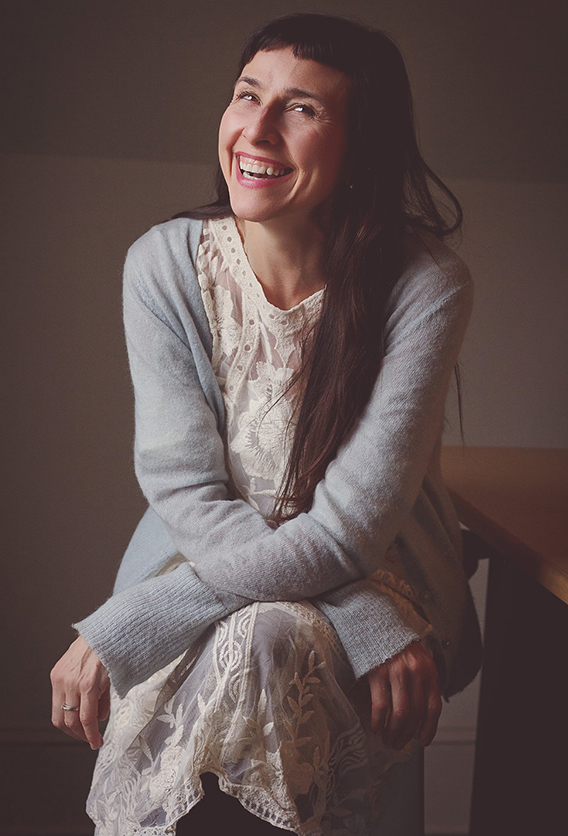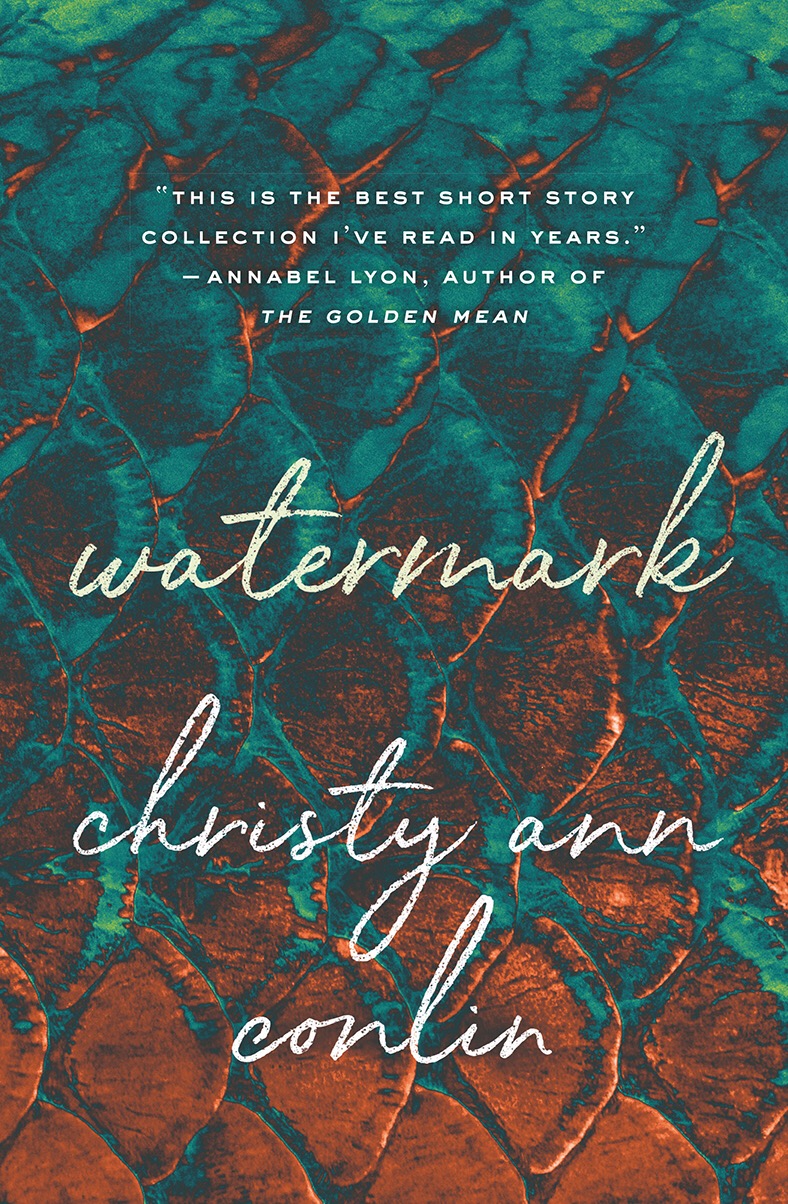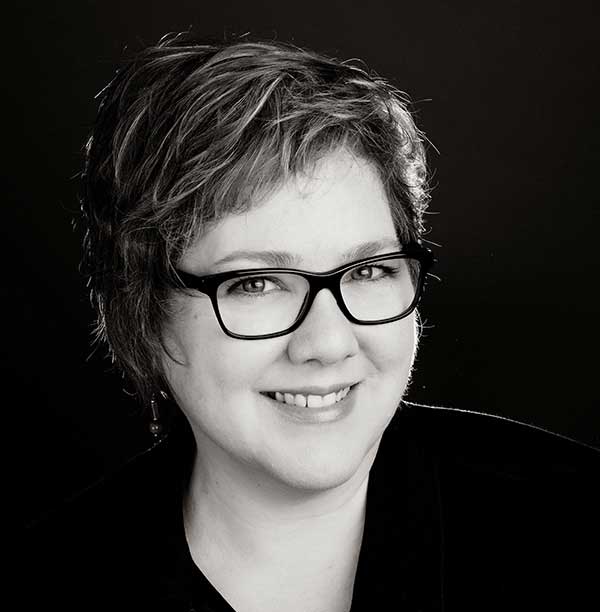Launched: Watermark by Christy Ann Conlin
By Laura Rock Gaughan

Christy Ann Conlin’s short story collection, Watermark, was published by House of Anansi in August. Based in Nova Scotia, she is the author of two acclaimed novels, Heave and The Memento, as well as the co-creator and host of the CBC radio series, Fear Itself. Our correspondence began with a postcard and quickly shifted to email.

Q: The eleven stories collected in Watermark upend expectations. They are quite varied—specific worlds yet all grounded in coastal geographies—with settings on the Atlantic and Pacific coasts, even the shorelines of Hudson Bay. Natural beauty comes with bleakness and danger: the sea as a source of wonder and peril, the remote mountain roads. Can you share your thinking about the harsh landscapes of your stories, and the people who live or hide out there?
I think geography and landscape, be it in its natural form or altered by people, has a massive impact on humanity. From a story point of view, drilling down, if you’ll pardon the pun, into how terrain impacts an individual and their community, is so artistically compelling. Mountains, valleys, oceans, water of all kinds, these are elemental forces at play in all of our lives, from the womb where we first swim, to our bodies comprised of so much water, a life force. The ocean and sea, rivers and streams, shape the land in the same way life and experience shape both the individual and society.
I lived in Vancouver for a long time, and my in-laws are all from British Columbia, so this bicoastal experience and contrast, the Pacific and the Atlantic in a kind of conversation, infuses the collection.

Q: Reading these stories had me recalling Ernest Buckler’s The Mountain and the Valley, although it’s been years since I read it in university—but isn’t this his geography, too, the harsh mountain where the main character dies, covered by snow?
I grew up on the Bay of Fundy shores. Buckler spent his life inland in the shadow of the South Mountain. The North Mountain and wild sea I grew up with had a very different impact on my life and by turn, how it shapes my work. When I was a teenager, I read The Mountain and the Valley. Its main impact on me was that I would die very young if I didn’t get the fuck out of Dodge, ha ha ha. While glimpses of the pastoral world Buckler loved still exist, for me the world was gashed open by technology. Both worlds exist, in conflict with each other, rarely in harmony. The only story in Watermark which speaks directly to Ernest Buckler is Beyond All Things Lies the Sea, where Seraphina flees the oppression of a traditional and conservative society which demolishes females and preys on vulnerability. Flight drives Seraphina’s life, escaping a restrictive past that imposes itself on younger generations. Seraphina is a Classical Studies scholar, and a student of Seneca. It is his words, beyond all things lies the sea, which she remembers, how we are nothing more than water and salt, that in the end, we return to the ocean. This story became the opening of my first novel, Heave.
Q: In “Dead Time”, we follow the thoughts of a teen who may or may not have committed murder. The story is told in the first person, from her cell, as she recounts the events that led to her incarceration. What inspired this story and its form?
Stylistically, it’s a stream of consciousness piece, a subversion of fairy tale, an extremely privileged unreliable narrator, who tells herself stories and explores her past, her choices and decisions. She is both preparing for what she’ll say publicly and conducting an excavation of self. What she discovers both horrifies and bewitches her. The story came about through two things. First, reading about the 2008 Toronto murder of Stefanie Rengel by teenager Melissa Todorovic. Todorovic was convicted of masterminding the murder of Stefanie Rengel, using a young man as her operative. Second, I taught literacy at a youth detention centre, working with young people who had committed very violent crimes. I came face to face with their humanity and inhumanity. It was a real reckoning of the idea of human and monster, what society creates, how it tries (and often fails) to protect and nurture the young. Isabella, the protagonist, is also telling her story in order to understand how adults and society have shaped and created her. It’s an origin story, of sorts, a distortion of autobiography. She views herself as a creature who has leapt out of a mythic realm. This allows her to justify crazy violence and brutality while at the same time, because she is so young, this is the only way she can make sense of what she is.
Q: Several of the stories reference characters that appear later, in other stories. There is a sense of weaving a community. Were the stories planned that way, or did the notion of subtly linking them come later, as you were compiling the collection?
The literary landscape in my mind has many intersections and this is why there are often glimpses of other characters, like glimmers and shimmers of a lake through a forest, the sound of a waterfall in the woods. I wrote the stories over a long period of time, from the late 1990s right through to 2018, so it wasn’t a question of planning, but of how my creative process works, returning to the same artistic terrain but exploring it from a different perspective, examining an alternative side. I wrote the stories individually, not with a collection in mind, so many of the subtle links surprised me when the stories came together in book form.
Q: How easily did the collection come together for you? I’m fascinated by decisions around ordering stories, and also, which to include and leave out.
This is such an interesting question. It’s my first collection, so it was all very new to me. Now that Watermark exists, I can say with hindsight, that I think writing stories with the intention of a collection is very different than how I did this—gathering the stories unto me, like a strange sort of shepherdess in the wilds, rounding up the wild wayward black sheep and seeing how they worked together as a flock. It’s a question of literary purpose and artistic form, but also, with the reader in mind, how they’ll enter into the world of the book, and come out the other side. The same goes for title selection. What a process that was!
It was really hard to know which story should go where. Of course, there are considerations such as length and contrast of style, as well. I wish I could have contemplated and played with story order for a long, long time. My amazing editor and I played around with different orders, and a few writerly friends also weighed in. It was like working with an opera, though, and moving one piece altered the collection as a whole. I have a new reverence for order of story. And what I was also very focused on were the titles, and how they looked together in the table of contents. They become a found poem. Even with a novel, I look at the chapter titles together on the page as a form of poetry.
Q: The older characters surprise the reader. We might be tempted to see them as sweet, or harmless, at first—they look like stereotypical grandmothers and even call the younger characters dear—but they are anything but. I’m thinking especially of Charlotte in “Full Bleed” and the old woman on her porch in “The Flying Squirrel Sermon”. Tell us about the damage that these older characters manifest, the threats they pose to the people who come back to visit.
I wanted to play with our stereotypes of the elderly, elderly women in particular, and how we so often underestimate them or completely misjudge them, based on society’s ageism and stereotypes. “Full Bleed” is a direct homage to Flannery O’Connor’s “A Good Man is Hard to Find”, written as a response to that story, a Northern Gothic response to her Southern Gothic.
Yes, and you gave your “misfit” character, Herman, the grace of a backstory in which he has been kind to his younger relatives on occasion, unlike the misfit in O’Connor’s story…
My story features a very problematic old lady and a young man’s deference, his grief- drenched naiveté, which ends up leading him into unexpected danger. In O’Connor’s work we are never quite sure who the villain is, who the wise one is, who is innocent, and who is sly. Our expectations are always disrupted. The older characters are upholders of the arcane ways. In “Full Bleed”, we see the terrible old ways, women who carry a violent and oppressive emotional power given to them by a patriarchal society. Lucretia in “The Flying Squirrel Sermon” is an entirely different kind of old woman, the last of her kind, keeping the old ways alive, finally able to tell her story to the young Ondine and introduce her to ancestral mysteries. I decided when I was writing many of these stories to view them through the eyes of Werner Herzog, to see the fascination and mystery in the obscure and unexpected.
Q: In several stories, the young people escape the life others plan for them, whether it’s leaving a man at the altar and racing for a flight overseas or leaving the community to go to university. The locals, the older characters, seem to want to weigh them down. Some wish their offspring would just be normal, meaning lead lives like their own—although those lives can seem circumscribed or severe. Were you conscious of commenting on the differences between generational expectations—that change over time in what could be expected from life—or is this more about place, or something else?
It’s all about that, this human conundrum which rises up between generations, of a sense of place where traditional expectations are KING and one must bow down before them, even if it means sacrificing your very self. This is especially true of the female characters in my stories, where they are time and time again expected to conform and betray themselves and their own humanity, in preservation of a society which sees them as nothing more than handmaids. Of course, in my stories, characters rail against this, fleeing, escaping, and often fighting against it, ultimately finding a sense of personal integrity and triumph. As a writer, I’m fascinated (and horrified) but this hallmark of rural life and the old-world culture of early immigrants and settlers, who are displaced in a world where they don’t belong, suffering from the loss of the world they left behind and inflicting damage everywhere they turn. I think every new generation is a chance for hope and transformation. And there is inevitably a massive conflict when those two worlds clash, or when the younger generation tries to extract itself and evolve into something new.
Q: What’s next?
I’m working on a memoir called Cross Trees about my big weird woven family, about life after breast cancer, how we find joy in a damaged life. And then there is my long-suffering novel.

Laura Rock Gaughan is the author of Motherish, a short story collection published in 2018. She lives in Lakefield, Ontario with her family.
Photos courtesy of Christy Ann Conlin.

